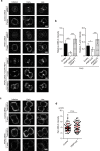Phospholipase C-related catalytically inactive protein regulates cytokinesis by protecting phosphatidylinositol 4,5-bisphosphate from metabolism in the cleavage furrow
- PMID: 31484968
- PMCID: PMC6726632
- DOI: 10.1038/s41598-019-49156-3
Phospholipase C-related catalytically inactive protein regulates cytokinesis by protecting phosphatidylinositol 4,5-bisphosphate from metabolism in the cleavage furrow
Abstract
Cytokinesis is initiated by the formation and ingression of the cleavage furrow. Phosphatidylinositol 4,5-bisphosphate [PI(4,5)P2] accumulation followed by RhoA translocation to the cleavage furrow are prerequisites for cytokinesis progression. Here, we investigated whether phospholipase C (PLC)-related catalytically inactive protein (PRIP), a metabolic modulator of PI(4,5)P2, regulates PI(4,5)P2-mediated cytokinesis. We found that PRIP localised to the cleavage furrow during cytokinesis. Moreover, HeLa cells with silenced PRIP displayed abnormal cytokinesis. Importantly, PI(4,5)P2 accumulation at the cleavage furrow, as well as the localisation of RhoA and phospho-myosin II regulatory light chain to the cleavage furrow, were reduced in PRIP-silenced cells. The overexpression of oculocerebrorenal syndrome of Lowe-1 (OCRL1), a phosphatidylinositol-5-phosphatase, in cells decreased PI(4,5)P2 levels during early cytokinesis and resulted in cytokinesis abnormalities. However, these abnormal cytokinesis phenotypes were ameliorated by the co-expression of PRIP but not by co-expression of a PI(4,5)P2-unbound PRIP mutant. Collectively, our results indicate that PRIP is a component at the cleavage furrow that maintains PI(4,5)P2 metabolism and regulates RhoA-dependent progression of cytokinesis. Thus, we propose that PRIP regulates phosphoinositide metabolism correctively and mediates normal cytokinesis progression.
Conflict of interest statement
The authors declare no competing interests.
Figures







Similar articles
-
The inositol 5-phosphatase dOCRL controls PI(4,5)P2 homeostasis and is necessary for cytokinesis.Curr Biol. 2011 Jun 21;21(12):1074-9. doi: 10.1016/j.cub.2011.05.030. Epub 2011 Jun 9. Curr Biol. 2011. PMID: 21658948
-
Suppression of cell migration by phospholipase C-related catalytically inactive protein-dependent modulation of PI3K signalling.Sci Rep. 2017 Jul 14;7(1):5408. doi: 10.1038/s41598-017-05908-7. Sci Rep. 2017. PMID: 28710365 Free PMC article.
-
A role for sphingomyelin-rich lipid domains in the accumulation of phosphatidylinositol-4,5-bisphosphate to the cleavage furrow during cytokinesis.Mol Cell Biol. 2012 Apr;32(8):1396-407. doi: 10.1128/MCB.06113-11. Epub 2012 Feb 13. Mol Cell Biol. 2012. PMID: 22331463 Free PMC article.
-
Phospholipase C-related but catalytically inactive protein, PRIP as a scaffolding protein for phospho-regulation.Adv Biol Regul. 2013 Sep;53(3):331-40. doi: 10.1016/j.jbior.2013.07.001. Epub 2013 Jul 17. Adv Biol Regul. 2013. PMID: 23911386 Review.
-
Regulation of the actin cytoskeleton by PIP2 in cytokinesis.Biol Cell. 2006 Jun;98(6):377-88. doi: 10.1042/BC20050081. Biol Cell. 2006. PMID: 16704377 Review.
Cited by
-
Vasoactive intestinal peptide-VIPR2 signaling regulates tumor cell migration.Front Oncol. 2022 Sep 27;12:852358. doi: 10.3389/fonc.2022.852358. eCollection 2022. Front Oncol. 2022. PMID: 36237322 Free PMC article.
-
Lipid Polarization during Cytokinesis.Cells. 2022 Dec 8;11(24):3977. doi: 10.3390/cells11243977. Cells. 2022. PMID: 36552741 Free PMC article. Review.
References
Publication types
MeSH terms
Substances
LinkOut - more resources
Full Text Sources
Research Materials
Miscellaneous

